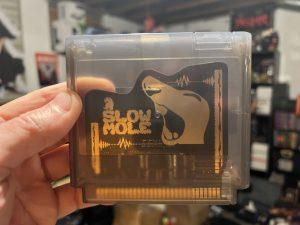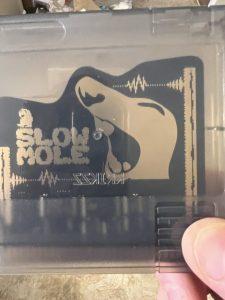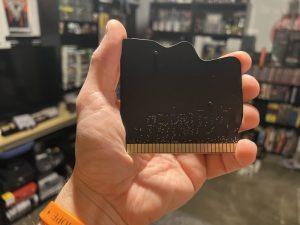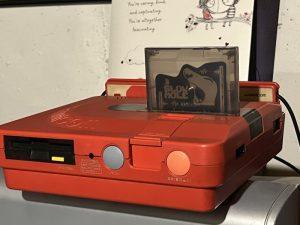New homebrew games happen often enough, but also, not often enough! Today’s entry into the hombrew world is already on update 1.2 (as of the time of this writing). However, I got to not only play the game, but I also have a physical copy that has version 1.1 written onto it. I’ve got gameplay footage, I’ve got pictures, and I’ve got thoughts. Let’s jump into the review of Slow Mole on NES!
Features/Description:
‘8-bit platformer for the NES that makes everyone a speedrunner. Playable on real hardware or modern devices. The whole game is designed around a unique checkpoint mechanic that will only award a checkpoint when the player proves their mastery of a screen. At the start, you have two difficulty options to choose from. They affect the timer, which might seem insignificant, but as you play you will notice makes a big difference.
For those who truly master the game, the mechanical nightmare challenge levels await…
It [Slow Mole] should take even high-skill players several hours to beat. Once finished, there are also unlockable bonus levels with a mechanical nightmare theme.
There is also a plus-version in development with more secrets, more music and some unique hardware features.
To learn more about Slow Mole +, please visit: https://www.patreon.com/erikrosenlund
Slow Mole is designed and developed by Erik Rosenlund
Music by Linus Rosenlund
Additional assembler coding and hardware design by Kristofer Thorell
© Erik Rosenlund 2021
The game has been developed using asmo-assembly, NES Maker 4.1.5 and FamiTracker’
Trailer:
Ways to Play:
- ‘On a computer: Download an emulator and just open the Slow Mole nes-file.
- On mini clone consoles: The game works great on softmodded mini consoles such as NES Classic. Works fine using the stock emulator, use the mapper 2-version.
- If you’re running Retro Arch [on any given platform], the mapper 2-version is recommended with Quicknes.
- On real hardware or FPGA consoles: The game has been tested and works great with Everdrive N8, Everdrive N8 Pro, PowerPak and KrzysioCart. To enable Power Mappers on PowerPak, use the mapper 2-version. On other setups the original version is recommended.
- NES, Famicom, RetroUSB AVS and NT Mini Noir as well as several NoaC-Famiclones.
- Also on Dreamcast’
Cartridge Trailer:
Gameplay Footage:
Pros/Cons:
- Speed, Speed, Speed! To start off this section, I thought it only appropriate to discuss the pacing of the game. If you watched my gameplay video, you’ll know what I’m talking about. I had a moment of realization in the game. A moment where I went “oh snap!” because I realized the schtick of it all. A similar thing happened ot me back when I played Super Paper Mario on the Wii. The very second that the whole thing changed from 2D to 3D, I lost my mind! There are always mechanics to every game, most of the mechanics are generic and are in practically every game. Some mechanics define a game though. Slow Mole has more than one piece to the puzzle, but the necessity of beating a level in a certain amount of time simply rocks. It’s one thing to say, okay, you have a time limit to a level. It’s another thing to give people more points for finishing the level ahead of the time limit.
This game doesn’t penalize you for finishing the level over the time limit, per se. Here’s how it works, you take note of the time in the corner and you go. If you finish it with time to spare, then that becomes your checkpoint. If you finish it over time, you simply move on. But the last level that you finished in under time is your last checkpoint. So it keeps the heat on. Maybe you finish 5 in a row over the time limit (very unlikely, but technically possible) but on the sixth level, you die. Guess what the punishment is for that? You’re going back 6 levels. You’re more likely to just go back one or two levels, but the pressure of the time limit is the thrilling pressure of it all. Once I realized that I lost my mind as I did with Super Paper Mario. I wanna kick this game out the window sometimes and other times I cherish it with all of my heart!
- Easiest Mode. I do believe that this game could stand to have a major improvement though. With as much as I love it, I feel that its entry point is not casual enough for some. I understand that there is an “Easier” mode already in this game. I know this because I had to use it to get as far as I did. But what I would enjoy seeing is a third mode added in. Maybe on a 2.0 iteration of Slow Mole. But that mode could be an “Easiest” difficulty.
The mode would be similar to “Easier” mode by having the same features as Easier but with the enemies moving 25% slower. This teaches the mechanics of the enemies and moving obstacles while still having the same jump gaps and stationary obstacles for them to learn. Such a mode could allow more casual people an entry point and/or people with ADHD such as myself could be rewarded sooner and more often. There are several types of mental debilitations that need rewards often so that we feel a sense of accomplishment in order to keep going.
- Audio. Kudos to Linus Rosenlund for some really great music in the game. The music in this title is easily my favorite chiptunes of the pandemic. The pacing of the music really keeps with the motion of the mole’s hecticness without being overbearing. I think we all know what I mean by video game music being overbearing. The same song looping can either be something that sounds good when paying attention and tunes out easily when not. There is also music that is atrocious and burrows its way into your brain when not paying attention to it and is distracting when you are.
I also find that the sound design is exactly balanced the way that it needs to be. If you play this game with the sound off even, you won’t be missing anything. But if you have the sound on, you have the perfect amount of information going to your ears. What I mean by that is that the game has exactly one jump sound and one “death” sound. You only need to hear if you’ve jumped and if you’ve died. Enemies aren’t pumping out sound, there are fall sounds, there isn’t the sound of the real world around you, etc. The bottom line here is that the game’s sound is 100% fat free, you only get what you need and nothing extra.
- Visual. Now it’s time for us to get into how the game looks. I am actually really fond of the design. Erik clearly opted to keep it looking simple. There’s no attempt at blue skies and clouds or background elements. Slow Mole moves left and right on a 2D plane. There’s no need to have distracting flare behind the character and the level. In fact, having extra elements might confuse obstacles on the foreground. The downside is that sometimes it is already hard to tell what you can’t positively interact with. It takes touching certain items before knowing if they are dangerous or not. My favorite part of the look of this title is how it’s (maybe accidentally) reminiscent of Sonic on Genesis/Mega Drive. The stage design starts off in more organic areas then it becomes more “civilized” as the game goes. The levels end in an organic looking world again, but I still like how it makes me think of Sonic!
- Mechanics. Now that we have discussed moving as fast as you can through boobie trapped levels, we can discuss other mechanics that are baked in. Jumping for instance. Jumping isn’t really jumping to this mole as it is to a regular game character. Jumping, I have found, is just as necessary to getting to the end as walking. However, I don’t use it for platforming alone. It seems to me that jumping a given direction moves you faster in the way you’re headed. Now, I’m not saying jump like a rabbit across every level. But if you can’t quite finish in time, try a hop or two. I could be wrong, but it does seem to help.

- Build Quality. I don’t even know where to start with this PCB that the game comes on. The photos below show more of the board than my video did. You can click to enlarge the image to see the quality of the cartridge. I think you’ll spot more things than I have pointed out, but I’m going to try to cover the most important bits. First off, just wow. The fact that they went with the black screenmask was the first brilliant touch. Then there is the printing for the PCB. By having a gold toned print on it, it not only matches the metal components of the board but it just oozes premium quality.
Second of all, I like the dual LED lights that complete the feeling of one of the electric wire obstacle. It’s present on the board by a print of the scary electrical obstacles. However, the game has nailed down its awesome factor when you turn the game on and the LED’s light up!
Next, the board is multilayered. Cheaper boards literally might only have 3 layers and have a flimsy quality to them. I’m uncertain as to which company manufactures these boards, otherwise I’d have specs for you. But rest assured, this thing is built like a brick building. It never succumbed to bending when inserting the game without a shell into the console. This physical cartridge feels more like a premium trophy to compliment an easier way to play it, like on an emulator. However, it can be played, for sure. So don’t be afraid of it!
- Cartridge Bummer. What I find to be a downside to the cartridge is the fact that the game continues to be updated but the cartridge is locked in as an older version of the game. Don’t get me wrong, I’m not saying they should stop updating the game. Instead, I’d rather see them hold off physical versions until the game is complete. If that won’t be happening, then I have another thought. If they could enable the customers with cart flashing tools the ability to flash updated version of the game. I know that the board they send you would be standard flash boards. I know that this would kill the unique look of the game. But you can circumvent this by putting them into cartridge shells with a custom game sticker on the shell. It’s just a thought!
UPDATE: Erik Rosenlund addressed this point on Twitter shortly after the tweet went live:
https://twitter.com/Checkoofilm/status/1482734238227210241?s=20
- Puzzles. Each level in Slow Mole is a puzzle itself with varying difficulties and design. The levels are pretty difficult, if I’m being truthful. It’s mostly difficult in a fun manner, but it’s complexity sometimes outweighs the thrill of beating a level in time. Some are simple straight across affairs with one or two obstacles. Those can be a fun jaunt to the finish line. Some others can be complex enough that if you do just one more time, you might just finish it under the limit. However, others are mazes with boobie traps galore and a time limit that seems 2 seconds too short. Look, all of the levels are smart and well crafted. Most of them are doable by human brains and hands. The ones that are not make you curse at your screen and use up 30 minutes of your life.
Final Thoughts:
Here goes a bit of a tangent since I’ve covered everything else I wanted to talk about with this game.
I honestly love Slow Mole. It could truly be a game that could’ve come out in 1989 and won the hearts of people all over the globe. For the future of this game, I would love to see this as a Game Boy game or a Game Boy Color game. However, I don’t mean a port. I mean a retooled version in that beautiful Game Boy green. Better yet, I would love to see sequels on different consoles to really make it a robust franchise of games. Sure you can make one game and port it to different consoles. But I truly think that there should be a bevy of these games on different systems. If you have every common system and handheld as I do, you could play them on physical hardware. If you don’t, you could play them on PC.








